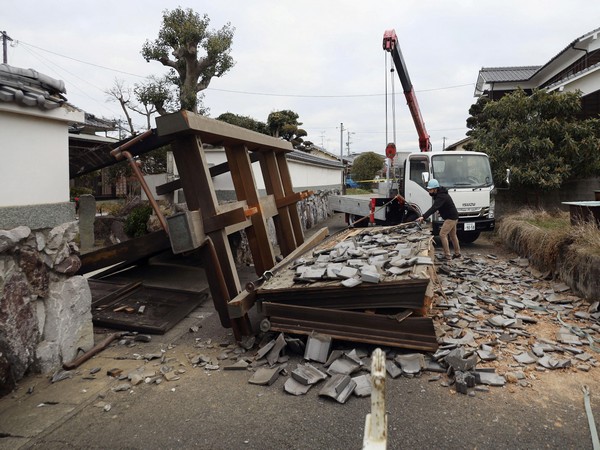
126 dead, 210 missing in Japan's Noto quakes amidst challenging aftermath
Jan 08, 2024
Tokyo [Japan], January 8: The death toll has surged to 126 in the central Japanese prefecture of Ishikawa after a series of earthquakes of up to 7.6 magnitude struck the prefecture and its vicinity, amid fears of secondary hazards and escalating casualties despite intensified rescue and search efforts on day six of the quake on Saturday.
The figure as of 1 p.m. local time marked the first time since the 2016 Kumamoto earthquake, which claimed 276 lives, that Japan has witnessed over 100 casualties due to an earthquake, including related fatalities, according to the weather agency.
Meanwhile, 516 people in Ishikawa suffered injuries due to the quakes, with 210 residents in the prefecture still unaccounted for as of 2 p.m. local time, according to local authorities.
The strongest temblor, officially named the 2024 Noto Peninsula Earthquake, is classified as a reverse fault earthquake with a preliminary magnitude of 7.6 by a government panel, and intermittent aftershocks are hampering recovery support to the affected areas.
Striking at a shallow depth centered around 30 km east-northeast of Wajima, the devastating quake on New Year's Day registered a maximum intensity of 7, with tremors felt in large metropolises such as Tokyo and Osaka.
The combination of frequent aftershocks and severe weather conditions poses a dual threat to the affected region, hampering rescue and relief operations and heightening the risk of secondary hazards.
In the latest update from the Japan Meteorological Agency (JMA), a 5.4-magnitude earthquake hit the Noto region at 5:25 a.m. local time on Saturday at a depth of 10 km, measuring upper 5 on the country's seismic intensity scale of 7.
Citing an unprecedented surge in seismic activity in the Noto region following the earthquake, the JMA said over 1,045 earthquakes registering intensity 1 or higher have been observed as of 8 a.m. on Saturday, over twice the total number of similar-intensity temblors recorded in the area over the past three years.
Officials warned that roads, already cracked from the dozens of earthquakes that continue to shake the area, could collapse completely.
Rain and snow expected overnight and Sunday for the region might further complicate the disaster-relief work, and the JMA also warned local residents to stay alert for possible mudslides and other possible secondary hazards.
On day six of the earthquake, the most-hit coastal city of Wajima confirmed 59 deaths, facing about 100 reports about people being buried and trapped under collapses of buildings.
Japan has deployed its Self-Defense Forces to strengthen their presence from about 5,000 to 5,400 personnel, in collaboration with local police and fire departments to intensify search and rescue efforts.
At a meeting of the emergency disaster response headquarters on Saturday, Japanese Prime Minister Fumio Kishida urged relevant departments to "spare no efforts in conducting search and rescue work," noting that "fatigue and stress are accumulating" for those taking shelters due to prolonged evacuation life.
With the full extent of wreckage still unknown, infrastructure has suffered severe damage in Ishikawa, with around 24,000 households facing power outages and 66,000 households left without water in 14 cities and towns as of 8 a.m. local time on Saturday, the national news agency Kyodo reported.
While some 31,400 people were staying at evacuation centers in Ishikawa, issues related to sanitation and hygiene were emerging, with some reports of COVID-19 infections and flu coming in, local media reports showed.
The prefecture was planning to initiate the installation of temporary housing in the cities of Wajima and Suzu starting next Friday to secure living accommodations for the affected residents.
More damage reports were coming in even outside Ishikawa, with liquefaction caused by continuous aftershocks being a major reason. As of Saturday, the New Year's Day quake has wrecked more than 2,000 homes in the city of Niigata alone, with over 150 buildings damaged.
The earthquake's direct economic impact, based on the current damage reports, could surpass 800 billion yen (about 5.5 billion U.S. dollars), which amounts to about 0.15 percent of Japan's nominal gross domestic product, according to Japanese economist Takahide Kiuchi.
Source: Times of Oman






